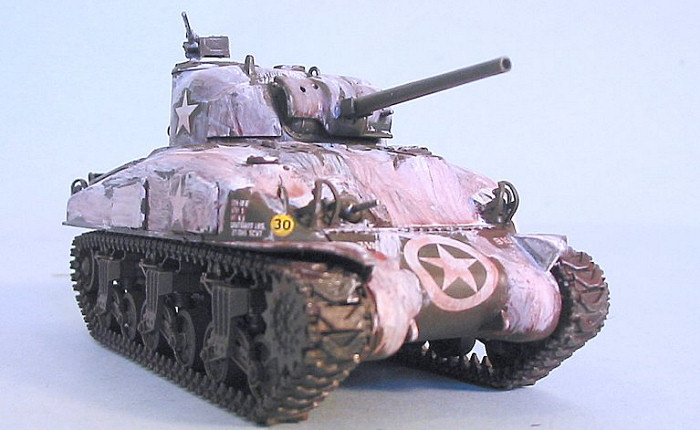
| KIT: | Tamiya 1/48 M4A1 Sherman |
| KIT #: | 32523 |
| PRICE: | 1600 yen at www.hlj.com |
| DECALS: | Three options |
| REVIEWER: | Tom Cleaver |
| NOTES: |

| HISTORY |
Much is made in military history about how the Sherman tank was outclassed by its opponents, with the unstated message being it was a second-rate armored vehicle which only ended up in the history books by the fact 10,000 of them were produced between 1941-45. While it is true that the Sherman could only overcome the Tiger and Panther tanks when it outnumbered them, one should remember that - at the time the Sherman was designed - the Tiger and the Panther didn’t even exist in their designer’s minds, let alone as hardware. When one compares the Panther against its perceived opposition, the Pzkw Ausf D medium tank, the Sherman looks pretty good. In fact, when the Sherman entered combat in North Africa in 1942, it was superior to the Pzkw IV tanks the Afrika Korps put up against it.
All of these tanks were originally designed to support infantry, and when it was doing the job it was designed for, the Sherman was excellent. In fact, in the Pacific - where there were no Tigers and Panthers - the Sherman was a standout. Its one big fault was the low-velocity 75mm cannon it had as its main armament. When it was upgunned with a 76mm cannon or the British 12-pounder, the Sherman had a lot of fight in it. When the Israelis upgunned it even more in the 1960s, the Sherman took on Syrian Pzkw IV Ausf J tanks, Soviet T-34s and J.S. IIIs, and even more modern Soviet armor quite successfully in both the Six-Day war and the Yom Kippur War, where one Israeli Sherman, fighting alone on the Golan Heights, took out a battalion of Syrian-manned T-54s.
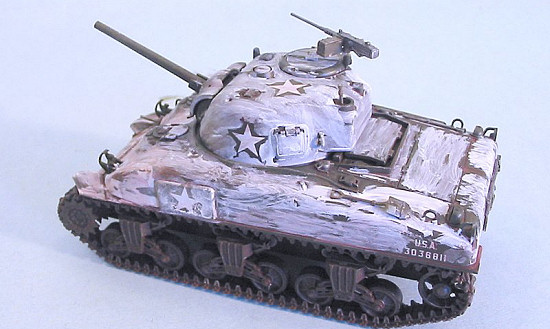 To
me, the Sherman is like the P-40: frequently called on to do missions it was
never designed for, and performing them well nonetheless against the odds.
There is an M4A1 Sherman out at Planes of Fame Air Museum which has been
restored to operating condition after many years’ service as an oversize
doorstop that makes quite a sight as it rumbles around the field, manned by
re-enactors in full tanker’s uniforms (including the leather football helmets)
and carrying a squad of “Band of Brothers” re-enactors atop the hull. It’s
definitely the best ride you can get when it’s time to head for beer call at the
main hangar after the annual air show.
To
me, the Sherman is like the P-40: frequently called on to do missions it was
never designed for, and performing them well nonetheless against the odds.
There is an M4A1 Sherman out at Planes of Fame Air Museum which has been
restored to operating condition after many years’ service as an oversize
doorstop that makes quite a sight as it rumbles around the field, manned by
re-enactors in full tanker’s uniforms (including the leather football helmets)
and carrying a squad of “Band of Brothers” re-enactors atop the hull. It’s
definitely the best ride you can get when it’s time to head for beer call at the
main hangar after the annual air show.
The 761st Tank Battalion - the original “Black Panthers”:
Among the many units to take the Sherman into combat, the story of one battalion stands out above the others: the 761st Tank Battalion, who had to fight for the right to fight before they ever got to the battlefield, where they covered themselves with glory.
While African-Americans have served in every American war since Crispus Attucks was killed by a Johnny Lobsterback in the Boston Massacre of 1770, and black troops served with such distinction during the Civil War that they won over 70 Medals of Honor on the battlefield, the two great wars of the 20th Century saw an official policy to keep them away from the field of battle and to deny those who did fight any recognition.
Woodrow Wilson may be in the mythological American pantheon for his idealistic vision of world-wide democracy during the First World War, but once one gets past the myth, the reality is that he did more than any other American president to destroy domestic democracy. He may have been the President of Princeton, but he was a narrow-minded Southern bigot who used the powers of his office to set in stone the rules of Southern white supremacy nation-wide, so far as the federal government was concerned. He also promoted Southern officers who shared his racial views to high rank, consolidating control of the American officer corps in the hands of Southerners for the first time since the Civil War. Wilson’s real political accomplishment was the official establishment of American Apartheid, which would not fall for 50 years. As a result of his policy, few African-Americans would serve in combat during the Great War. There were National Guard units - like the 369th Infantry Regiment from Harlem (who incidentally were responsible for introducing Europe to jazz) - who served with distinction in the final battles. During the Meuse-Argonne Offensive, they were the unit who rescued the famous “Lost Battalion.” Somehow, Wilson’s Four Freedoms didn’t include seeing that their service made it into the history books.
 At
the outset of the Second World War, Franklin Roosevelt had the difficult task of
leading a party formed of Northern progressives and Southern reactionaries, with
the Southerners in control of the House of Representatives and the Senate due
to congressional seniority, which rewarded the fact that Southernism is a
one-party system (back then they were called “Democrats” - today they’re called
“Republicans”). What gains African-Americans did make came in spite of
government resistance. Equal opportunity in the defense industry only came
after A. Phillip Randolph, President of the Brotherhood of Sleeping Car Porters,
threatened a March on Washington in 1942 that would have publicly exposed
American “democracy” for the white supremacist farce it then was.
At
the outset of the Second World War, Franklin Roosevelt had the difficult task of
leading a party formed of Northern progressives and Southern reactionaries, with
the Southerners in control of the House of Representatives and the Senate due
to congressional seniority, which rewarded the fact that Southernism is a
one-party system (back then they were called “Democrats” - today they’re called
“Republicans”). What gains African-Americans did make came in spite of
government resistance. Equal opportunity in the defense industry only came
after A. Phillip Randolph, President of the Brotherhood of Sleeping Car Porters,
threatened a March on Washington in 1942 that would have publicly exposed
American “democracy” for the white supremacist farce it then was.
Nothing would have changed in the armed forces had not Eleanor Roosevelt used her position as First Lady to convince her husband to force the Pentagon to take African Americans for duties other than that of “field hands” in the rear.
One result of this was the Tuskeegee Airmen - the other was the 761st Tank Battalion.
In 1942,as a result of the efforts of Eleanor Roosevelt, A. Phillip Randolph and the NAACP, working with Lt. Gen. Lesley J. McNair, the chief of Army Ground Forces who agreed with them that cutting the country off from the service of an entire community made no military sense, a handful of all-black units - under the overall command of white officers - were created, among them was the 5th Tank Group with the 758th, 761st, and 784th tank battalions, which was formed on April 1, 1942. Throughout the Army, the men who joined up were known as “Eleanor Roosevelt’s ni**ers.”
The 761st initially trained at Camp Claiborne near Alexandria, Louisiana, where the troopers were greeted with substandard living conditions in the least desirable areas of the camp, and contending with racial tensions on and off base.
The outstanding officer in the unit was the battalion executive officer, Lt. Col. Paul L. Bates. Though ridiculed by other white officers, Bates believed in the mission and remained loyal to his men — and they to him. Assuming command of the unit on July 4,1943, after the white supremacist originally in command was relieved of duty for harassing his troops, Bates was a superb leader who challenged his men and expected them to excel. He remained the commanding officer until November 1945 and was absent only due to wounds received in action in November 1944.
Retired Lt. Colonel Philip Latimer, a high school math teacher in East Texas before the war, recalled his service in the 761st:
“I served as a private in the 3rd Armored Division and a sergeant in the 7th Armored Division before enrolling in Armor Officer Candidate School and becoming a second lieutenant in October 1942. In January 1943, all second lieutenants in the 12th Armored Division were asked if they would be willing to serve with black tankers. I had grown up in an area where there had been many blacks and with parents who were not prejudiced. I was also a very patriotic person, and so I said yes because I felt that perhaps I was extremely well qualified to do this. Knowing they were getting all southern white officers, I felt they would only have a chance if some unprejudiced officers volunteered to serve.”
 In
early 1943, the 761st was sent to Fort Hood Texas, where they trained
on the M4 Sherman and M5 Stuart tanks. The Army never considered they would be
sent into combat, and instead assigned them to work as the “aggressor unit” at
the Tank Destroyer Center, training anti-tank units equipped with the M-18.
Under the leadership of Colonel Bates, the 761st became so good they
regularly beat the anti-tank units. As other armored battalions came through,
were trained and sent on to combat, the men of the 761st ached to
receive a combat assignment. As Latimer recalled:
In
early 1943, the 761st was sent to Fort Hood Texas, where they trained
on the M4 Sherman and M5 Stuart tanks. The Army never considered they would be
sent into combat, and instead assigned them to work as the “aggressor unit” at
the Tank Destroyer Center, training anti-tank units equipped with the M-18.
Under the leadership of Colonel Bates, the 761st became so good they
regularly beat the anti-tank units. As other armored battalions came through,
were trained and sent on to combat, the men of the 761st ached to
receive a combat assignment. As Latimer recalled:
“One of the sad parts of our training experience was the treatment received by our black tankers when they left the post area. These men were in the uniform of their country and were later to fight and some to die for their country. Even so, they were constantly mistreated and verbally abused by some elements of the civilian population. It is remarkable that they could continue to train diligently. The thing that kept them going was their determination to show the world that they could fight in tanks and win.”
The invasion of Europe changed everything. In the Norman bocage, the U.S. Army met the Tiger and Panther tanks, and the panzerfaust - all used by an army with three years’ experience in modern armored warfare as practiced on the Eastern Front. The wastage of American armor skyrocketed in the summer of 1944, forcing General George S. Patton, Jr. - who had once said publicly that “blacks are too slow” to be able to fight in modern armored warfare - to ask that all available units in the United States be sent to Europe. After 18 months of training when the usual unit went overseas after six months, the 761st received orders for overseas shipment that August, and arrived in France in late September. Once formed up and equipped, they were addressed by their new commander in late October, as recalled by Philip Latimer:
He stood in the back of a half-track as he spoke to us. He was an imposing figure, and his voice rang out loud and clear:
“Men, you're the first Negro tankers to ever fight in the American Army. I would never have asked for you if you weren't good. I have nothing but the best in my army. I don't care what color you are, so long as you go up there and kill those kraut SOBs. Everyone has his eyes on you and is expecting great things from you. Most of all, your race is looking forward to you. Don't let them down and, damn you, don't let me down.”
Shortly thereafter, the 761st entered combat in Lorraine on November 10, when Company A, attached to the 104th Infantry, attacked Vic-sur-Seille. Sergeant Warren G.H. Crecy fought through enemy positions to assist the infantry until his tank was destroyed, at which point he took command of another vehicle, armed with only a .30-caliber machine gun, and destroyed the enemy position that had hit his tank. Still under heavy fire, he directed artillery to eliminate the enemy forward observers who were directing the fire that had been pinning down the infantry. The next day, the company assaulted Chateau-Salins in a four-hour fight in the season's first snowstorm. When Crecy's tank was bogged down in the mud, he dismounted in the middle of anti-tank, artillery and machine gun fire to extricate his tank. While doing this, he saw the infantry was pinned down and the enemy had counterattacked. He climbed onto his immobilized tank and held off the Germans with his .50-caliber machine gun while the infantry withdrew. A few hours later, he wiped out several machine-gun nests and an anti-tank position armed only with his machine gun. The more fire he drew, the harder he fought. After the battle, Crecy had to be pried away from his machine gun.
 On
the 12th they repulsed an enemy counterattack near Wuisse, destroying
two enemy tanks. On the 13th, a platoon acting on its own
counterattacked and took Wuisse, holding it through the night until the rest of
the force could move up. Throughout these fights, the tank commanded by Staff
Sgt. Ruben Rivers was in the forefront. On the 16th, they assaulted
Guebling. Rivers' tank hit a mine while advancing with his company and his leg
was slashed to the bone by the explosion. He refused a morphine injection, and
also refused to be evacuated. Taking command of another tank, Rivers led attacks
on enemy positions east of Guebling through the morning of the 19th,
despite the company losing three of its five tanks to antitank fire and one to
mines. Continuing toward Bourgaltroff they were stopped by enemy fire. The
company commander ordered a withdrawal but Rivers radioed he had spotted the
antitank position. He drove forward, covering the withdrawal of the rest of the
company until the tank was hit by several panzerfausts, killing him and
wounding the rest of the crew.
On
the 12th they repulsed an enemy counterattack near Wuisse, destroying
two enemy tanks. On the 13th, a platoon acting on its own
counterattacked and took Wuisse, holding it through the night until the rest of
the force could move up. Throughout these fights, the tank commanded by Staff
Sgt. Ruben Rivers was in the forefront. On the 16th, they assaulted
Guebling. Rivers' tank hit a mine while advancing with his company and his leg
was slashed to the bone by the explosion. He refused a morphine injection, and
also refused to be evacuated. Taking command of another tank, Rivers led attacks
on enemy positions east of Guebling through the morning of the 19th,
despite the company losing three of its five tanks to antitank fire and one to
mines. Continuing toward Bourgaltroff they were stopped by enemy fire. The
company commander ordered a withdrawal but Rivers radioed he had spotted the
antitank position. He drove forward, covering the withdrawal of the rest of the
company until the tank was hit by several panzerfausts, killing him and
wounding the rest of the crew.
It was the unofficial policy of the U.S. Army during the war that no African-American would be given the Medal of Honor, and both Crecy and Rivers were awarded the Silver Star. Crecy later received a battlefield commission and remained in the Army, becoming a famed combat leader during the Korean War. On December 2, 1997, following a 20-year campaign to get the Army to review awards, the daughter of Staff Sgt. Rivers received her father’s Medal of Honor from President Clinton at the White House.
Following the battles in Lorraine, the 761st moved on with the Third Army, as the Germans attacked in what became known as The Battle of the Bulge. Informed that the 101st Airborne was surrounded at Bastogne, Patton accomplished the difficult feat of turning his direction of attach 90 degrees and proceeded with the relief of the 101st. At the village of Tillet, supporting the 17th Airborne Division, the 761st went up against the Panthers, Tigers and Hetzers of the 12th SS Panzer Division in a four-day fight before the Germans retreated after suffering heavy losses. The winter road conditions were so bad that they had to use their light tanks to bring up supplies.
In 1981, Gen. William M. Miley, commanding general of the 17th Airborne, wrote:
“During the Ardennes operation we had very little armored unit support, but of that we did have the 761st Tank Battalion was by far the most effective and helpful... My most vivid recollection of the 761st Tank Battalion was an action in support of the 194th Glider Infantry Regiment. The regiment had been stopped in its attack on a well-fortified hill. When they regrouped to renew the attack, the attack was led by one of the companies of the 761st. They led the way up the hill with so much accurate fire that the hill was seized without the loss of a single airborne soldier."
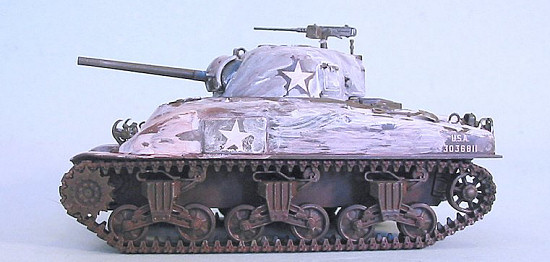 In
March 1945, the 761st, with a battalion of infantry from the 103rd
Infantry Division, attacked the Siegfried Line at Klingenmunster and forced the
Germans to withdraw across the upper Rhine. The 14th Armored Division was then
passed through to exploit the breakthrough they had created. Moving on through
central Germany, the 761st liberated the Gunskirchen Lager
concentration camp in late April, saving over a thousand Jews. On May 6, 1945,
the 761st met the Red Army at Steyr, Austria. They were the
easternmost unit of all the Western Allied forces in Europe.
In
March 1945, the 761st, with a battalion of infantry from the 103rd
Infantry Division, attacked the Siegfried Line at Klingenmunster and forced the
Germans to withdraw across the upper Rhine. The 14th Armored Division was then
passed through to exploit the breakthrough they had created. Moving on through
central Germany, the 761st liberated the Gunskirchen Lager
concentration camp in late April, saving over a thousand Jews. On May 6, 1945,
the 761st met the Red Army at Steyr, Austria. They were the
easternmost unit of all the Western Allied forces in Europe.
The 761st was recommended for a Presidential Unit Citation shortly after the end of the war, but it was turned down by the Army. In 1978, following review of the unit’s actions, President Jimmy Carter gave the 761st their long-overdue award. The citation chronicles a remarkable achievement:
“The men of the 761st Tank Battalion, while serving as a separate battalion with the 26th, 71st, 79th, 87th, 95th, and 103rd Infantry Divisions, the 17th Airborne Division and Third, Seventh and Ninth Armies in 183 continuous days in battle, fought major engagements in six European countries, participated in four major Allied campaigns, and on 6 May 1945, as the easternmost American soldiers in Austria, ended their combat missions by joining with the First Ukrainian Front of the Russian forces at the Enns River, Steyr, Austria. Throughout this period of combat, the courageous and professional actions of the members of the "Black Panther" battalion, coupled with their indomitable fighting spirit and devotion to duty, reflect great credit on the 761st Tank Battalion, the United States Army, and this Nation.”
Today, there is a memorial to the 761st at Ft. Hood, where they trained, and the story of their fight is well-known in the Armored Corps of an American Army that - today - is the one American institution where the ideal of “equal opportunity for all” comes closest to reality.
| THE KIT |
To see what’s in the box, read Scott Van Aken’s preview.
| CONSTRUCTION |
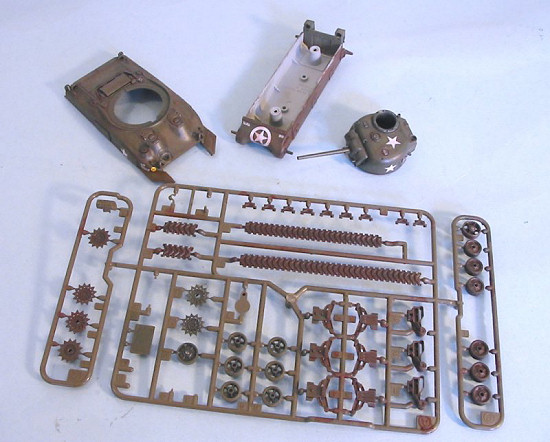 Sometimes, even Modeling Madness reviewers find it useful to read full-build
reviews in the Modeling Madness archives, and I was greatly helped in this
project by first reading Scott’s full-build review of this kit.
Sometimes, even Modeling Madness reviewers find it useful to read full-build
reviews in the Modeling Madness archives, and I was greatly helped in this
project by first reading Scott’s full-build review of this kit.
As with the other Tamiya kits in this range, the M4A1 Sherman is beautifully designed for easy construction, while providing good detail with separate small parts throughout.
I first did all the assembly of small parts to the hull other than the tools which would be added after assembly and painting. I then proceeded to the turret, having decided to do the “C” version of the three possibilities, since this was identified as a Sherman that had served in France in 1944. My plan, having seen an excellent documentary on The History Channel this past month on the 761st Tank Battalion that had sent me doing further research and coming away very impressed, was to build a Sherman tank that could have been used by the 761st.
Once the hull and turret were assembled, it was time to move on to painting the model.
| COLORS & MARKINGS |
Painting:
The major part of this project was painting and finishing the model.
I had been very struck by a photograph in the History Channel documentary of the Shermans of the 761st during the Battle of the Bulge, covered in patchy winter camouflage and mud. Since the Panther tank I had just done was one used by the 12th SS Panzer Division and thus might have been one of the participants in the Battle of Tillet, I decided I would do this Sherman in winter camouflage to represent a tank of the 761st in that fight.
I
started by painting everything with Xtracrylix “RAF Dark Green.” Research has
shown that what is known as “Army Olive Drab” began life as a color based on the
British First World War “P.C.10" camouflage color. While this was a color that
covered a multitude of production sins under the same name, the official color
is close to what later became “RAF Dark Green.” I felt additionally that a
green-base color was right based on our Sherman out at Chino, which is still in
its original - now much-faded - paint, which is definitely a green-base “olive
drab.”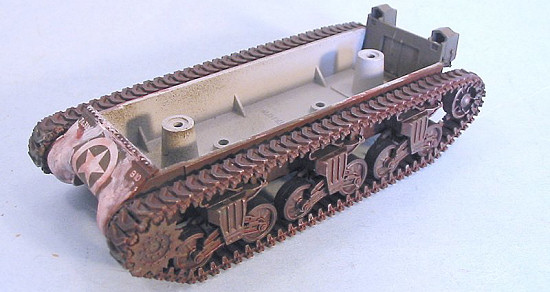
After painting everything with this color, I added in some Xtracrylix “Olive Drab” and went back over it, blotching the paint to fade it. I then added in some Xtracrylix “Faded Olive Drab”, thinned the paint in the cup more, and went back over all the parts to complete the fading process. I also painted the treads with Tamiya “NATO Black,” and hand-painted the bogie wheels with this color.
I then gave the parts a coat of Future and applied the decals. When these were set, I gave everything two coats of thinned Xtracrylix Flat Varnish.
After all this was dry, I drybrushed the parts - particularly the bogie wheels and rollers - with ModelMaster flat aluminum. I also did this to the treads, to show wear. This was followed by a wash of thinned “NATO Black” to “pop-out” detail and further “grunge-up” the paint. I followed that with a wash of Tamiya “Red Brown” to simulate mud over the road wheels, lower hull and tracks.
The photos I had seen of the Shermans in their winter camo showed a scheme that can best be described as “ragged.” It would appear the tanks were painted with brushes, without cleaning the vehicles before painting, so that the paint was very uneven in application and was subject to severe wear. I thinned some Tamiya “Flat White” and took a flat-tip brush that was about a “scale” 8 inches wide - the sort of brush most likely used on the real thing - and slopped on the white paint. This was followed with a brush application of thinned Tamiya “Red Brown” to put mud over the winter camouflage. Any tank operating in an environment where only tanks could bring supplies forward would definitely be “a pig in mud.”
| FINAL CONSTRUCTION |
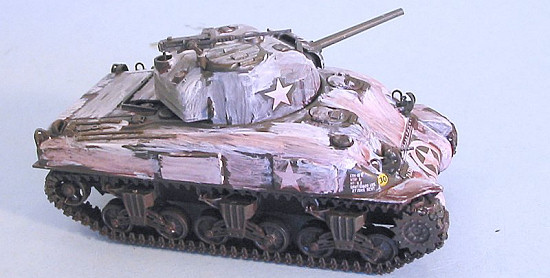 I
assembled the bogies and drive wheels, and attached them to the lower hull. I
did not glue the drive wheels, so they could be moved as necessary to fit the
tracks properly. Assembly of the tracks to the wheels was made easy by the fact
there is a pin on the forward roller wheel, that corresponds to a hole in the
upper track, so it can be positioned exactly right. Attaching everything else
to this upper part makes the whole thing come together much easier than the
other tanks I have done in this series.
I
assembled the bogies and drive wheels, and attached them to the lower hull. I
did not glue the drive wheels, so they could be moved as necessary to fit the
tracks properly. Assembly of the tracks to the wheels was made easy by the fact
there is a pin on the forward roller wheel, that corresponds to a hole in the
upper track, so it can be positioned exactly right. Attaching everything else
to this upper part makes the whole thing come together much easier than the
other tanks I have done in this series.
With the lower hull finished, I attached the upper hull wit
h screws, covered over the screw holes with the plates, and then attached all the tools as indicated in the instructions. I finished off by attaching the machine gun to the turret and fitting the turret to the hull.
| CONCLUSIONS |
All of the tanks I have done so far have been weathered to be part of a specific
moment in a specific battle. I plan to eventually create small dioramas for
each, since I personally think that is the best way to display a tank. This
“Winter Sherman” gets around the problem of having a tank that is
“monochromatic,” and comes up with a realistic reason for the “over-weathering.”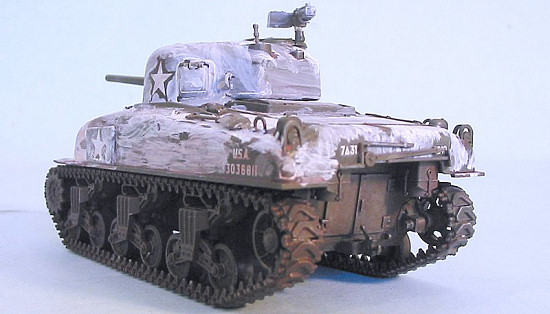
What I find amazing is how small tanks really are. I think of our Sherman as being pretty big when I stand next to it, but sitting this model next to the Tamiya P-47, or any of the others next to any 1/48 airplane model, reveals just how small these vehicles are, relatively speaking (that said, I remember turning the atmosphere inside my car deep purple, being stuck behind an M1A1 Abrams on a tank transporter that took up two freeway lanes on Interstate 5 here in Los Angeles a few years ago - it was plenty big!). I’m having a lot of fun with these Tamiya small armor kits, and look forward to doing the rest of the series as they come out. As a break from “serious airplane modeling,” they really can’t be beat.
Thanks to HobbyLink Japan for the review kit. Get yours at www.hlj.com
| REFERENCES |
DiNicolo, Gina: “The 761st Tank Battalion;” Military Officer Magazine; February, 2006.
Latimer, Phillip, LCOL (Ret.): “When The Black Panthers Prowled;” Army Magazine; January 1992.
Website of the 761st Tank Battalion -
If you would like your product reviewed fairly and quickly by a site that has over 300,000 visitors a month, please contact me or see other details in the Note to Contributors.